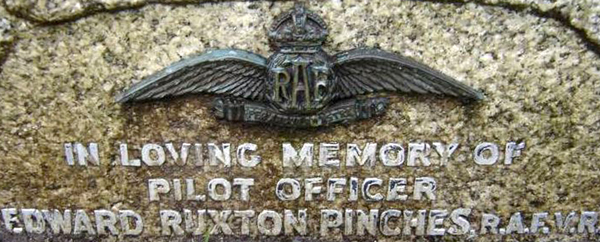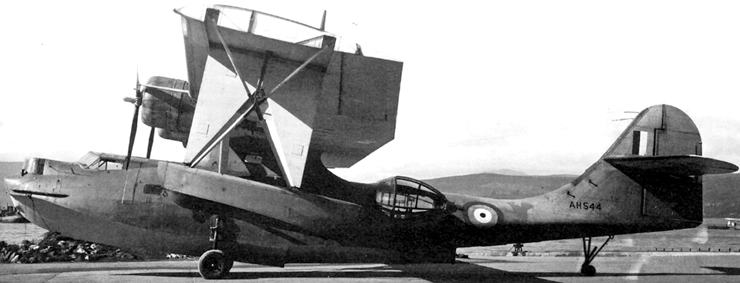AN OVERNIGHT stay in Helensburgh in 1941 would have seemed a very welcome contrast to spending countless hours in Catalina seaplanes searching the grey Atlantic for U-Boats.
Alas that is not how it turned out, retired Merseyside newspaper editor Robin Bird — an expert on the Marine Aircraft Experimental Establishment at RAF Helensburgh — has discovered.
Robin has extensively researched and written two books about the MAEE, which was based in Rhu and Helensburgh, and he is campaigning with Helensburgh Heritage Trust for a memorial to the men and women who served there to be erected here.
This is his story of Consolidated Catalina AH 533, which was at RAF Helensburgh for an overhaul . . .
Squadron Leader Patrick Hutchinson, of 210 Squadron, a 27 year-old, and a scratch crew were flown to Helensburgh from Oban by Pilot Officer Ted Southwell on July 14 1941 to collect AH 533.
The crew consisted of the co-pilot Edward Ruxton Pinches, Sergeant Wireless Operator Edwin Cyril Graham, Corporal James Calder Kinniard, Corporal Tudor Simner-Jones, Leading Aircraftman Charles Arthur Kew, Aircraftman First Class Ronald Feamley and Aircraftman John Kelly.
Catalina patrols of the Atlantic for U-Boats took a toll on both aircrew and aircraft. In contrast RAF Helensburgh was generally regarded as a ‘good place to be at’ during the war.
Visiting RAF crews hosted by the MAEE stayed at Rhu, either in the officers mess, or airmen’s quarters. The officers mess at Ardenvohr was the requisitioned Royal Northern Yacht Club headquarters and retained opulent surroundings previously enjoyed by yacht club members.
Off duty pilots and aircrew drank in the Rhu Inn and the flying boats were serviced and repaired at Rhu Hangars, or on the slipway.
There is no record of what Squadron Leader Hutchinson and his crew did during their short stay at Helensburgh — no doubt they had time on their hands before taking off the following day.
What they did not know was that July 15 1941 was to be a fateful day. All of them, with the exception of John Kelly, would never see another day dawn.
MAEE was experienced in servicing flying boats of all kinds, not least Catalinas.
It had serviced Britain’s first Catalina after a long flight from America, and Catalinas and Sunderlands from operational squadrons were regular. Consolidated Catalina Mk 1 AH533/DA-G of No 210 Squadron was overhauled, serviced and checked. It would have then been signed for by the Squadron Leader as being ready to fly before taking off along the Gareloch.
Pilot Officer Ted Southwell, an experienced pilot who had previously flown Sunderlands with 210 Squadron, took off first for Oban, about an hour ahead of Hutchinson. His Catalina arrived safely at Oban, Hutchinson did not.
A search was mounted. Pilots included Percy Hatfield, who had spotted the fleeing Bismarck during a record 27-hour flight in a Catalina. He was posted to Helensburgh in 1942 as test pilot and survived a Walrus crash on the Gareloch.
The search for the missing AH 533 was initially conducted over the sea in the wake of Southwell’s flight. Hatfield reported ‘nothing seen’.
Other pilots, anxious to locate their lost colleagues, reported nothing spotted. Then at 4.37 pm the burned out wreckage of the crashed Catalina AH 533 was spotted by ‘new boy’ in the squadron, Aircraftman Don Campbell.
He was being flown by Wing Commander Barrett when they spotted the scattered wreckage of AH 533 on the Isle of Jura. The exact location was on high ground on Cruach na Seilcheigh, at the northern end of the island.
Campbell said they landed nearby and went to the crash scene to find John Kelly the only survivor. His leg was smashed.
The remains of the rest of crew were taken back to Oban by pinnace.
It seems that after Hutchinson had taken off from Helensburgh, he approached Oban by a different route to Southwell. In bad weather he damaged AH 533 attempting to land.
He took off again to attempt a second landing, possibly to put down AH 533 on water and await better weather.
While flying in low cloud the Catalina struck high ground, crashed and burst into flames. Bits of wreckage remain to this day.
The irony of AH 533’s last flight was if Hutchinson had left Helensburgh an hour earlier with Southwell, the crash would not have happened.
Southwell flew via the Sound of Bute flying all the way at between 3,000 and 4,000 ft with visibility of three miles. Had Hutchinson followed the same route he would have made base.
There seems to be confusion as to whether AH 533 had contacted Oban by radio saying that it had problems. Maybe, Hutchinson thought it not necessary as they had almost ‘made it home’.
The Squadron Leader was described as “a fine officer. One of the nicest men you could wish to meet.”
He was the only son of Major George Stuart Menteith Hutchinson and Sybil Hutchinson, and his wife Barbara lived at Royston, Hertfordshire.
At the time of his death Patrick Hutchinson’s home address was given as The Haven, Oban. On Thursday December 18 1941, his wife gave birth to their daughter.
Lone survivor Kelly was treated in hospital for his injuries. He recovered but with a slightly shortened leg.
This is just one sad story concerning aircrew who had spent time at RAF Helensburgh, who were killed in flying accidents or by enemy aircraft while serving with the operational squadrons.
 Robin Bird whose late father was the MAEE photographer at Helensburgh, said: “They are part of the bigger, untold story that was RAF Helensburgh.”
Robin Bird whose late father was the MAEE photographer at Helensburgh, said: “They are part of the bigger, untold story that was RAF Helensburgh.”
World War Two aircraft wreckage searcher Doug Darroch, curator of Fort Perch Rock on Merseyside, is hoping to visit Jura. He told Robin that he will place a poppy cross at the wreck scene if time allows.
210 Squadron had Sunderlands replaced by Catalinas during April 1941. In the batch of Catalinas assigned to them with AH533, were AH 532 and AH 535, both of which ‘failed to return’ from patrols.
“Ironically, AH 533 has wrongly been recorded in national records as having taken part in the capture of U-570 and the Enigma cipher machine on August 27 1941,” Robin said.
“This dramatic event was the stuff that films are made of, but it was not Catalina AH 533 that was involved but Catalina AH 553. AH 535 was by that date no more.”





